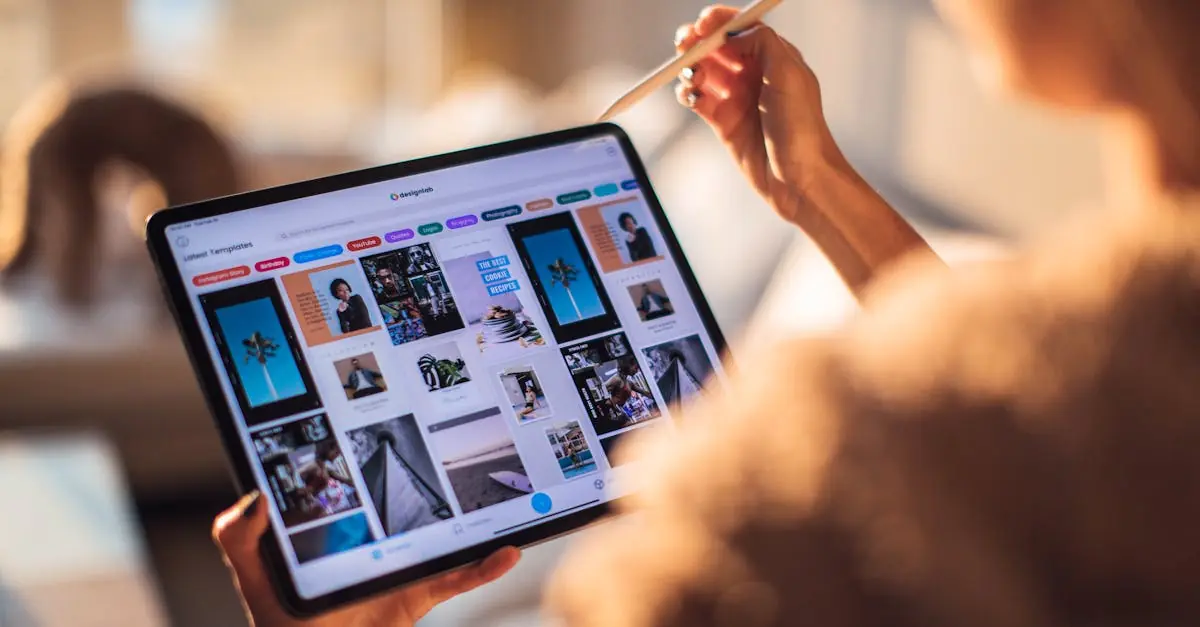In a world where everyone’s glued to their screens, the design of a mobile app can make or break its success. Imagine a beautifully crafted app that feels like a warm hug for your fingers. Now picture a clunky, confusing interface that leaves users feeling like they just tried to assemble IKEA furniture without the instructions. Quite the difference, right?
Table of Contents
ToggleOverview of Mobile App Design
Mobile app design plays a crucial role in user engagement and retention. An intuitive layout significantly enhances user satisfaction, making navigation a smooth experience. Designers should prioritize usability to meet functional needs, ensuring elements are easily accessible.
Visual aesthetics also influence how users perceive an app. Effective use of color schemes, fonts, and imagery can create an appealing interface. Consistent branding elements foster familiarity and trust.
User feedback shapes design decisions. Regularly incorporating user insights leads to improvements and innovations. Designers often utilize prototypes to test functionalities before full-scale development.
Adapting to various screen sizes remains essential. Responsive designs provide optimal viewing across devices, enhancing accessibility. Consideration for performance impacts load times and overall user experience.
Strong mobile app design also includes attention to micro-interactions. Subtle animations and feedback can guide users through tasks, making interactions engaging. Simplification of complex processes encourages user goal completion without frustration.
Current design trends impact user expectations. Incorporating minimalism, dark mode, and card layouts can keep an app relevant. Continuous evaluation and adaptation ensure alignment with user needs and technological advancements.
Ultimately, a well-executed mobile app design balances functionality, aesthetic appeal, and user feedback. This combination fosters a positive user experience, setting the foundation for an app’s success.
Key Principles of Best Mobile App Design
Best mobile app design adheres to specific principles that enhance user experience and satisfaction. Successful apps prioritize usability and aesthetics to create engaging interfaces.
User-Centric Design
User-centric design focuses on understanding users’ needs and preferences. Gathering feedback through surveys or usability testing shapes design decisions effectively. This approach fosters an intuitive experience, ensuring users can navigate easily and achieve their goals. Incorporating user personas can guide the design process. Designers should prioritize functionality that aligns with user expectations while considering diverse user behaviors. Testing design prototypes with real users helps identify pain points early. Continuous iteration based on user feedback leads to a refined and highly functional app.
Consistency and Branding
Consistency in design reinforces brand identity and improves user familiarity with the app. Maintaining uniform color schemes, typography, and iconography creates a cohesive experience. When users encounter familiar elements, their navigation becomes smoother. Branding extends beyond visuals; the tone of voice in the app’s content contributes to the overall user experience. Establishing a recognizable style strengthens brand loyalty while ensuring that users can reliably predict how to interact with the app. In addition, regular updates should reflect existing brand guidelines to keep the experience consistent.
Accessibility Considerations
Accessibility encompasses design choices that enhance usability for individuals with disabilities. Offering alternative text for images ensures that visually impaired users can engage with the content. Utilizing clear, readable fonts benefits all users, making text easy to comprehend. Designers must consider color contrast to support users with visual impairments. Implementing features like voice commands can aid users with mobility challenges. Testing the app with diverse user groups helps identify accessibility barriers, leading to comprehensive improvements. Prioritizing accessibility fosters inclusivity, allowing a broader audience to enjoy the app’s functionality.
Essential Design Elements
Design elements significantly impact the functionality and appeal of a mobile app. Focusing on these components leads to a successful user experience.
Color Schemes and Typography
Color schemes ensure the app communicates its brand identity. Designers should choose colors that evoke the desired emotions and reinforce the brand message. For typography, legibility remains crucial. Using contrasting colors between text and background enhances readability. A unified font style across titles, body text, and buttons promotes consistency. Combinations of one or two font types often yield a cleaner aesthetic. Users engage better when the color palette and typography align harmoniously.
Navigation and User Flow
Navigation serves as the backbone of user experience. Clear pathways enable users to locate information swiftly, supporting efficient task completion. Intuitive navigation structures, including tab bars and hamburger menus, guide users seamlessly. A well-planned user flow minimizes task completion time, enhancing satisfaction. Designers should prioritize landmark features, such as back buttons, for easy orientation. Testing navigation structures with actual users reveals potential pain points, ensuring smoother transitions throughout the app.
Visual Hierarchy
Visual hierarchy directs user attention to important elements within the app. Placing critical information in prominent locations fosters engagement. Size and color variation can highlight calls to action effectively. Designers often employ spacing and alignment to create clear distinctions among content sections. Grouping related items visually aids in user understanding. Consistent application of hierarchy principles leads to a more intuitive interface. Users appreciate when their focus aligns with the intended priorities of the app.
Top Examples of Best Mobile App Design
Examining top examples of mobile app design reveals effective strategies and creative solutions used by industry leaders. Innovative features and user-centric approaches shine through in these designs.
Case Study: Leading Brands
Popular apps like Airbnb and Spotify showcase exceptional design principles. Airbnb combines intuitive navigation with stunning imagery, creating an immersive user experience. Spotify emphasizes vibrant color schemes and clear typography, boosting brand recognition among users. Both apps prioritize user feedback to refine their interfaces continually. Insights from users lead to streamlined processes and enhanced functionalities in updates. These case studies illustrate how leading brands leverage design to captivate and retain their audiences.
Innovations in Design Trends
Recent innovations in mobile app design focus on enhancing user engagement through aesthetics and functionality. Trends like minimalism prioritize clean interfaces, reducing distractions for users. Dark mode options appeal to consumers seeking reduced eye strain while maintaining a modern look. Additionally, incorporating micro-interactions enriches user experiences by making engagement feel personal and dynamic. Adoption of voice-based interfaces transforms how users interact with apps, fostering accessibility and convenience. Keeping up with these design innovations empowers developers to create competitive and effective mobile applications.
Effective mobile app design is essential for creating a positive user experience that drives engagement and retention. By focusing on usability, aesthetics, and user feedback, designers can craft interfaces that resonate with users. Prioritizing elements like responsive design, accessibility, and visual hierarchy ensures that apps not only meet but exceed user expectations.
Staying attuned to current design trends and incorporating innovative features can further enhance functionality and appeal. Ultimately, a successful mobile app design harmonizes these principles, resulting in an intuitive and enjoyable experience that keeps users coming back.




